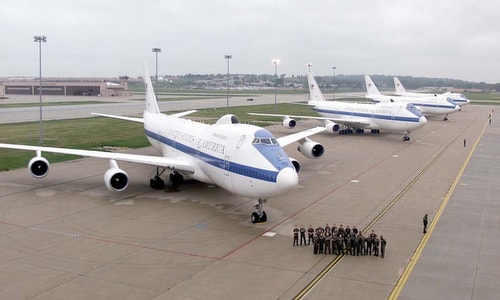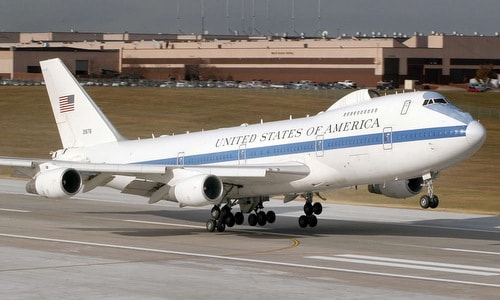About the tornado that nearly destroyed America's 'Doomsday' squadron
A lack of hangars caused two E-4Bs to be severely damaged in a tornado, leaving the US with only one "Doomsday" aircraft on standby.
|
A squadron of four E-4B Nightwatch aircraft of the US Air Force. Photo: USAF |
On June 16, 2017, a tornado with winds of 135-175 km/h swept through Offutt Air Force Base in the central United States and severely damaged two E-4B Nightwatch aircraft, also known as "doomsday planes". The incident left the US with only one E-4B capable of operating for three months, showing the vulnerability of the most important squadron in Washington's nuclear defense plan, according toDrive.
The tornado also severely damaged eight RC-135 reconnaissance aircraft at Offutt Air Force Base. The total damage from the tornado was about $20 million, of which the cost of repairing two E-4Bs accounted for $8 million. The US Air Force only had four Nightwatch aircraft, in addition to the two damaged by the tornado, a third was undergoing maintenance at the Boeing factory. In fact, 75% of Washington's mobile war command force was disabled before participating in combat.
“The storm took the worst possible path, and it was fortunate that no one was hurt,” recalled Col. Dave Norton, commander of the 55th Airlift Wing, based at Offutt Air Force Base, which operates the Air Force’s fleet of E-4Bs, RC-135s, and other reconnaissance aircraft.
The E-4B is a mobile war command center, carrying dozens of military analysts, strategists and communications assistants to assist the US president. They are equipped with many special components, such as wire antennas up to 8km long to maintain communication with nuclear submarine forces, even if ground communication stations are destroyed.
When they take off, they will be called the National Air Operations Center (NAOC). In operation since the 1970s, the E-4B has always been the best option for the US president to survive a nuclear attack.
Before the June 16, 2017 tornado, the 55th Wing commander decided to move two E-4Bs into hangars due to concerns about hail. These hangars were not large enough to cover the entire E-4B, but they still protected the cockpit, wings, engines, and many antenna and electronics compartments along the fuselage.
|
The hangar only protected part of the fuselage and wings of the plane. Photo:OAFB. |
Despite operating the E-4B fleet, Offutt doesn’t have a hangar large enough to protect it from hurricanes. The base’s location deep in America’s “tornado valley” further increases the risk of damage to the aircraft. Typically, the E-4B and RC-135 fleets are evacuated to other areas when a tornado approaches. This process requires extensive planning and time, making it impractical in most tornado cases.
When the tornado hit Offutt, high winds whipped the E-4Bs’ massive tail fins, which were exposed outside the hangar. The winds were so strong that the 190-ton E-4Bs were easily pushed into the hangar, smashing into objects inside. The walls and roof were also destroyed, exposing everything inside to the terrible conditions of the tornado.
“The noise was deafening,” said Master Sgt. Ken Parker, who was overseeing hangar security at the time. The tornado slammed the engine of one E-4B into the maintenance area, punching a large hole in the front of the engine. The other suffered a ruptured fuel tank, but base firefighters were able to contain it before the leaking fuel caught fire.
Details of the damage to the two E-4Bs are still unclear, but it could have been much worse. Master Sergeant Parker, Tech. Olivia Fernandez, and Walter Scott were all awarded medals for their quick response before the tornado hit. They risked their lives running from the shelter to the hangar, then released the locking pins on the two E-4Bs’ landing gear.
|
An E-4B takes off from Offutt Air Force Base. Photo: OAFB |
"If the front landing gear is not unlocked and free to move, it can break and cause the nose of the aircraft to hit the ground. We try to save the aircraft as much as possible," Parker explained.
It took the Air Force three months to get the Nightwatches back in working order, but the incident highlighted the weaknesses and difficulties in maintaining the aging fleet of E-4Bs. The planes, which are based on the Boeing 747-200 airframe, have been out of production since the 1970s and have seen their operating and maintenance costs skyrocket in recent years.
Currently, US defense corporations have not proposed to replace the E-4B fleet, while Washington has not requested the design of a new war command aircraft. This will cause the E-4B fleet to remain in service for at least the next 20 years and face many safety threats, including strong tornadoes in the Offutt base area.




